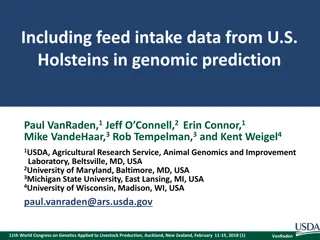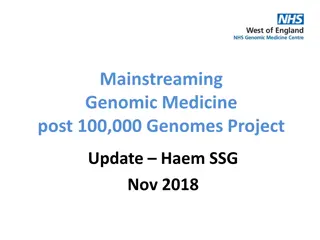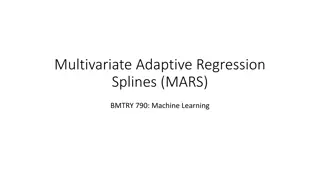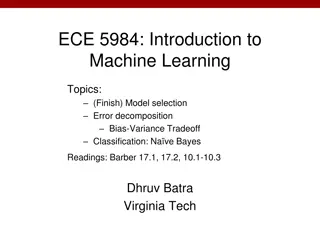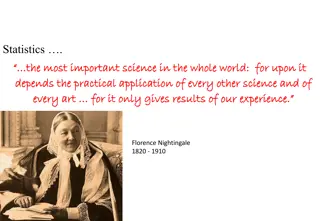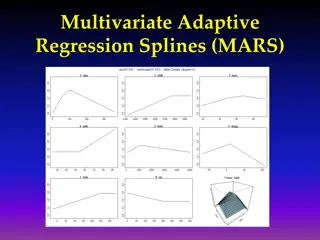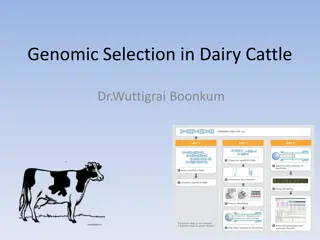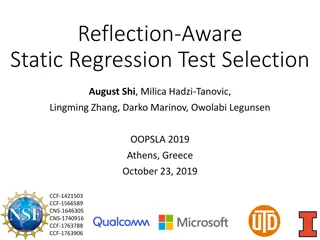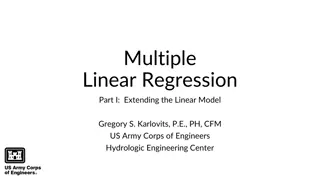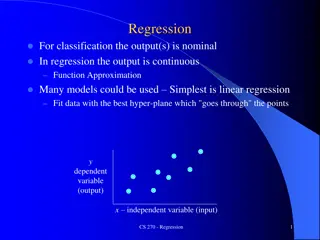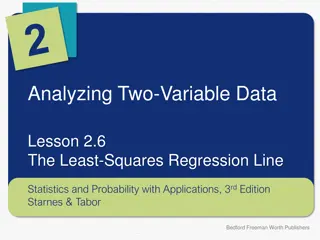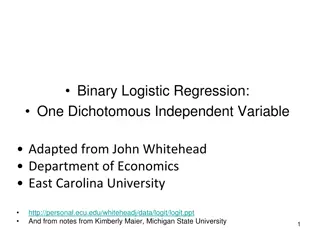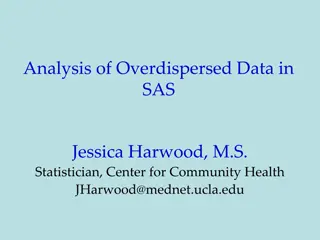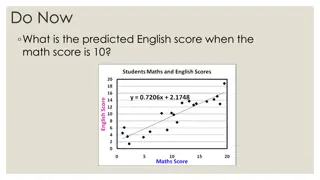Understanding Ridge Regression in Genomic Selection
Explore the concept of ridge regression in genomic selection, involving the development of genomic selection methods, pioneers in implementation, fixed and random effects, and the over-fitting phenomenon. Learn how ridge regression addresses issues of over-fitting by introducing regularization parameters and balancing fixed and random effects to improve the accuracy of predicting genetic values in individuals.
Download Presentation

Please find below an Image/Link to download the presentation.
The content on the website is provided AS IS for your information and personal use only. It may not be sold, licensed, or shared on other websites without obtaining consent from the author. Download presentation by click this link. If you encounter any issues during the download, it is possible that the publisher has removed the file from their server.
E N D
Presentation Transcript
Statistical Genomics Lecture 25: Ridge Regression Zhiwu Zhang Washington State University
Administration Homework 6 (last) due April 28, Friday, 3:10PM Final exam: May 4, 120 minutes (3:10-5:10PM), 50 Course evaluation starts on April 17
Outline Concept development Ridge Regression rrBLUP package
Development of genomic Selection MAS works for a few genes Over-fit CV Does not works for polygenes Inaccurate Concept in 1990s implement in 2000s Whole genome RR and Bayes gBLUP =RR Pedigree+Marker cBLUP/sBLUP
Concept development Over fitting Governed by less parameters Free fixed effects into random effects Only regulate their distribution Random effects = total genetic effects of individuals Random effects = effects of markers
Fixed effect Specific interest, nothing behind, e.g. a fertilizer Limited levels, e.g. M and F only for sex Access to any specific level No distribution
Random effect Population behind, e.g. average and variance Many levels, e.g. individuals genetic effects Distribution No control to access a specific level
Pioneers of implementation RR and Bayes
Fixed effect model SNP1 SNP2 S1 0 2 SNP4 SNP5 S4 2 0 observation mean b= PC2 b1 ] S2 1 2 S5 0 2 [ b0 2 0 0 2 2 0 2 0 x6 x5 y [ 1 x1 x2 x3 ] y = Xb +e
Fixed effect model over-fitting SNP1 SNP2 S1 0 2 SNP9 SNP10 S9 2 0 observation mean b= PC2 b1 ] S2 1 2 S10 0 2 [ b0 2 0 0 2 2 0 2 0 x10 x9 y [ 1 x1 x2 x3 ] y = Xb +e
BLUP of individuals Ind1 u1 1 0 Ind2 u2 0 1 Ind19 Ind20 u19 0 0 observation mean b= PC2 b1 u= [ ] u20 0 0 [ ] b0 0 0 0 0 1 0 0 1 y [ 1 x1 x2 ] =X Z y = Xb + Zu +e
Switch individuals to SNPs SNP1 SNP2 S1 0 2 SNPm-1 SNPm Sm-1 2 0 observation mean b= PC2 b1 s= [ ] S2 1 2 Sm 0 2 [ ] b0 2 0 0 2 2 0 2 0 M y [ 1 x1 ] =X y = Xb + Ms +e
BLUP on individuals y = Xb + Zu + e 2),e~N(0, I??2), u~N(0, A?? ? ? ? ? ? ? ? ?=? ? ? ? +??2 2? 1 ? ? ?? 1 ? ? ? ? ? ? ? ? ? ? ? ? +??2 = ? ? 2? 1 ??
BLUP on markers (Z to M, and u to s) y = Xb + Ms + e 2),e~N(0, I??2),? = ? s~N(0, A?? ? ? ? ? ? ? ? ?=? ? ? ? +??2 2? 1 ? ? ?? 1 ? ? ? ? ? ? ? ? ? ? ? ? +??2 = 2? 1 ?? ??
Ridge Regression Independently invented in many contexts Different names: e.g. Tikhonov regularization (1963), Phillips Twomey method, and constrained linear inversion Tikhonov, A. N. (1963). " ". Doklady Akademii Nauk SSSR151: 501 504.. Translated in "Solution of incorrectly formulated problems and the regularization method". Soviet Mathematics4: 1035 1038. Phillips, D. L. (1962). "A Technique for the Numerical Solution of Certain Integral Equations of the First Kind". Journal of the ACM9: 84. doi:10.1145/321105.321114.
rrBLUP vs. gBLUP s~N(0, I r2) rrBLUP y=x1s1 + x2s2+ + xpsp + e A a2) gBLUP ~N(0, U
u=Ms if A=MM
R packages for ridge regression rrBlupMethod6 ridge Lm.ridge (from MASS): library(MASS) rrBLUP
rrBLUP R package Ridge Regression + BLUP EMMA to estimate variance components
rrBLUP on CRAN rrBLUP: Ridge Regression and Other Kernels for Genomic Selection Software for genomic prediction with the RR-BLUP mixed model. One application is to estimate marker effects by ridge regression; alternatively, BLUPs can be calculated based on an additive relationship matrix or a Gaussian kernel. Version: 4.4 Depends: R ( 2.14) Suggests: parallel Published: 2015-10-28 Author: Jeffrey Endelman Maintainer: Jeffrey Endelman <endelman at wisc.edu> License: GPL-3 URL: http://potatobreeding.cals.wisc.edu/software NeedsCompilation: no Citation: rrBLUP citation info Materials: NEWS CRAN checks: rrBLUP results Downloads: Reference manual: rrBLUP.pdf Package source: rrBLUP_4.4.tar.gz Windows binaries: r-devel: rrBLUP_4.4.zip, r-release: rrBLUP_4.4.zip, r-oldrel: rrBLUP_4.4.zip OS X Snow Leopard binaries: r-release: rrBLUP_4.4.tgz, r-oldrel: rrBLUP_4.3.tgz OS X Mavericks binaries: r-release: rrBLUP_4.4.tgz Old sources: rrBLUP archive Reverse dependencies: Reverse depends: GeneticSubsetter Reverse imports: PopVar
Setup GAPIT #Import GAPIT #source("http://www.bioconductor.org/biocLite.R") #biocLite("multtest") #install.packages("EMMREML") #install.packages("gplots") #install.packages("scatterplot3d") library('MASS') # required for ginv library(multtest) library(gplots) library(compiler) #required for cmpfun library("scatterplot3d") library("EMMREML") source("http://www.zzlab.net/GAPIT/emma.txt") source("http://www.zzlab.net/GAPIT/gapit_functions.txt")
Import data and simulation #Import demo data myGD=read.table(file="http://zzlab.net/GAPIT/data/mdp_numeric.txt",head=T) myGM=read.table(file="http://zzlab.net/GAPIT/data/mdp_SNP_information.txt",hea d=T) myCV=read.table(file="http://zzlab.net/GAPIT/data/mdp_env.txt",head=T) #Simultate 10 QTN on the first half chromosomes X=myGD[,-1] index1to5=myGM[,2]<6 X1to5 = X[,index1to5] taxa=myGD[,1] set.seed(99164) GD.candidate=cbind(taxa,X1to5) mySim=GAPIT.Phenotype.Simulation(GD=GD.candidate,GM=myGM[index1to5,],h2=. 5,NQTN=20, effectunit =.95,QTNDist="normal",CV=myCV,cveff=c(.01,.01))
Ridge Regression vs. gBLUP #Import rrBLUP #install.packages("rrBLUP") library(rrBLUP) 15 10 #prepare data y <- mySim$Y[,2] M=as.matrix(X) 5 ans2$u 0 -5 #Ridge Regression ans1 <- mixed.solve(y=y,Z=M) -10 -10 -5 0 5 10 15 M %*% ans1$u #gBLUP K <- tcrossprod(M) #K = MM' ans2 <- mixed.solve(y=y,K=K) #Compare GEBV plot(M%*%ans1$u, ans2$u)
rrBLUP vs GAPIT myGAPIT <- GAPIT( Y=mySim$Y, GD=myGD, GM=myGM, group.from=1000, group.to=1000) myGAPIT$Pred[thematch, 5] 10 order.raw=match(taxa,myGAPIT$Pred[,1]) plot(ans2$u, myGAPIT$Pred[order.raw,5]) 5 0 first=c("c","a","b","d") -5 second=c("a","d","c","e","f") match(first,second) -10 -10 -5 0 5 10 15 [1] 3 1 NA 2 ans2$u
Highlight Concept development Ridge Regression rrBLUP package






